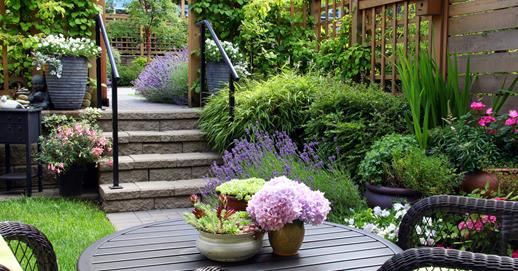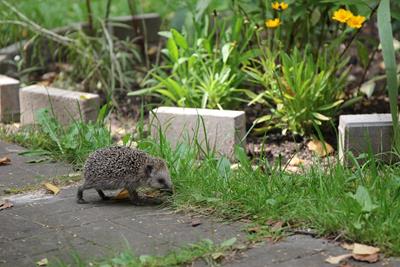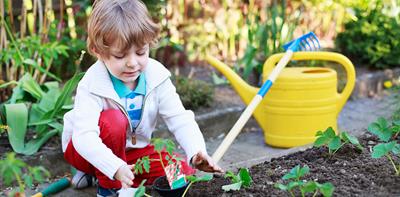
Whether your garden is a bit narrow or it’s simply just a tiny space, it’s amazing what you can do with a bit of love, care and inspiration. We’ve gathered some simple ideas to help you create a lovely retreat where you can relax, enjoy some sunshine and get some fresh air.
We all know how important it is to get out of the house when we can. It’s good for us both physically and mentally. So, get your Monty Don head on, or George Clarke, and see how these ideas can help you get the most from your outside space, however limited it may be.
Make a plan
First things first, if you intend to maximise your space and create a refuge for you and your family, then you need a plan.
You don’t need to be a landscape gardener to make some simple drawings or sketches. Just be sure to measure out the garden so you can plan to scale.
You may need to make a list of priorities. When space is limited, your garden could quickly end up looking too busy if you try and cram in too much and fail to achieve the desired effect. Decide what you want most from your garden, and keep that as the focus.
Create zones
If your garden is long and narrow, as is often the case for terraced houses, then consider zoning.
The idea is to create separate areas, with their own personalities and purpose. It needn’t be fancy or complex. Depending on the size of your garden, you might have a bit of lawn, a gravelled seating area, a veg patch - even if it’s just a raised bed - and some fruit trees.
Use screening
Screening can be a cheap and effective way to divide up your outdoor space.
There are plenty of options available depending on the look you’re going for. From bamboo, willow or reed screening to a trellis to grow plants up – living walls are very effective and great for attracting insects too. Alternatively, you could use shrubs to do the same job.
Screens can also hide items like wheelie bins or unused garden furniture.
Diagonal paving
Garden planners have several tricks up their sleeves to maximise small garden spaces. One of these is to use diagonal paving to give the optical illusion of a bigger garden.
Take the indoors outside
If your garden is bound by walls, then make use of them, much like you would inside your house. Fix big, rustic-looking shelves on which you can put potted plants of varying sizes. You can hang outdoor lighting on your walls too, and mirrors are another great feature that add real interest and create space. We even have an old fireplace against a wall which makes it feel like an outdoor room; the final touch is an outdoor rug I have my eye on.
Vary layers and sizes
Creating different levels, even if just means adding a step or two, can add new perspectives and interest to your garden. Steps and ledges also provide extra spots for plant pots or furniture.
In the same spirit of mixing shapes and sizes, you could fill your small outside space with a selection of potted plants of varying sizes.
A cosy corner
Turn tiny into cosy. A small corner can make for a lovely seating area.
You can add a splash of colour to differentiate your snug corner, such as some tiling, and outdoor cushions in the warmer months.
Kitchen garden
Just because you only have a small plot, it doesn’t mean you can’t grow your own. It’s amazing what you can achieve in pots or planters dotted across a small garden. Herbs are very happy in pots, as are vegetables like spring onions, runner beans or tomatoes[1].
Hanging baskets work wonders too for strawberries and tomatoes - just watch the squirrels don’t get them before you.
Make it fun for kids
If you have young children, a small garden can be challenging. But they needn’t miss out. Find a spot to build a playhouse - it can be small and raised off the ground. Or find a spot against a fence or wall to squeeze in a small mud kitchen. This is one of the best things we did and it encourages them to be outside.
Also, why not give them a small plot of their own: your children could take responsibility (with your help) for tending to some of their own veg-growing pots.
Winding or curved path
A path can make all the difference to a small garden. It can help with zoning and provide a focal point. Don’t just put it straight down the middle – it can start on one side of the garden and twist and turn and adds another point of interest.
Smart storage
If space is at a premium, then how about a mini greenhouse? There are plenty of options for lean-tos or small wooden framed greenhouses.
Other smart storage solutions include benches that double up as storage boxes. Depending on the type of space you have, you might be able to create some built in seating that doubles up as storage.
Use fold up furniture
It’s a simple tip but using fold up furniture can make a big difference when you’re trying to save space.
If you use furniture that folds up, then you can easily put it away when you’re not using it, and get it out again when the sun is shining, ensuring you’re only using up space when you need it. You can even buy half-moon (semi-circle) tables that fit snugly against a wall or fence, if you’re really struggling for space.
Consider privacy
If you have a small garden in a town or city, then it’s probably overlooked. Trying to make your whole garden private may be unrealistic, but perhaps you can make a small area private, such as a seating area? You could use trellis, a pergola or shrubs and trees.
Pergolas are fantastic for growing climbers or hanging some outdoor lighting too.
For tips on how to stay happy and safe in your home and garden, go to Solved.
[1] https://www.gardenersworld.com/plants/space-saving-veg-crops-to-grow/


